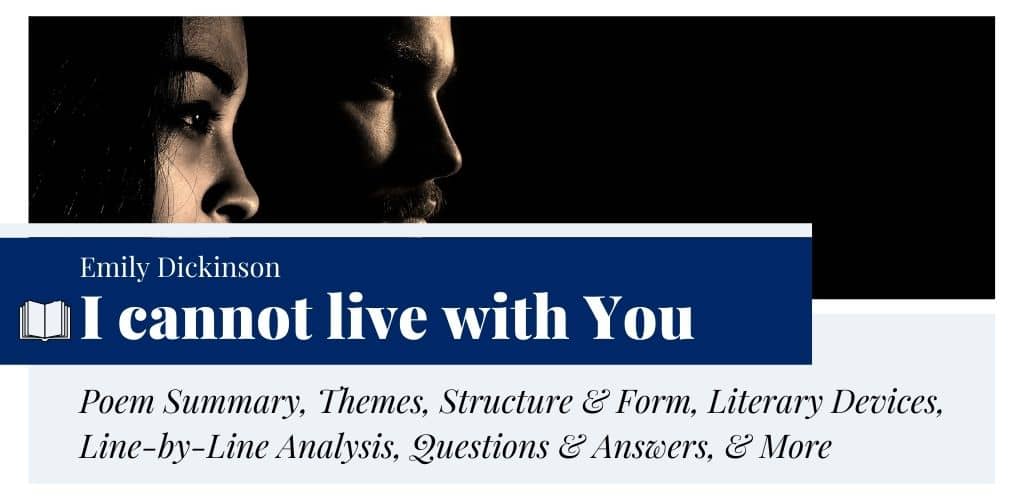I cannot live with You by Emily Dickinson
“I cannot live with You” is a “Quaint” lyric poem composed by one of the greatest 19th-century American poets, Emily Dickinson. It appears as poem number 640 in the collection, The Complete Poems of Emily Dickinson, edited by Thomas H. Johnson, published in 1955. Dickinson’s poignant style takes center stage in this poem that deals with the pangs of a loving heart that cannot be united with its lover. She captures the inner turmoil of a lover (partly feminist and partly devoted) who, throughout the poem, talks about why she cannot be with the person she loves. The speaker cites various reasons for her decision and addresses her lover to explain her suffering and pain in being away from him. Besides, she addresses her lover as “You” throughout the poem keeping their identity gender-neutral.
- Read the full poem “I cannot live with You” below:
I cannot live with You – (640) by Emily Dickinson I cannot live with You – It would be Life – And Life is over there – Behind the Shelf The Sexton keeps the Key to – Putting up Our Life – His Porcelain – Like a Cup – Discarded of the Housewife – Quaint – or Broke – A newer Sevres pleases – Old Ones crack – I could not die – with You – For One must wait To shut the Other's Gaze down – You – could not – And I – could I stand by And see You – freeze – Without my Right of Frost – Death's privilege? Nor could I rise – with You – Because Your Face Would put out Jesus' – That New Grace Glow plain – and foreign On my homesick Eye – Except that You than He Shone closer by – They'd judge Us – How – For You – served Heaven – You know, Or sought to – I could not – Because You saturated Sight – And I had no more Eyes For sordid excellence As Paradise And were You lost, I would be – Though My Name Rang loudest On the Heavenly fame – And were You – saved – And I – condemned to be Where You were not – That self – were Hell to Me – So We must meet apart – You there – I – here – With just the Door ajar That Oceans are – and Prayer – And that White Sustenance – Despair – - from The Complete Poems of Emily Dickinson (1955)

Summary
In “I cannot live with You,” Dickinson talks about the other aspect of desire; how “love” is not the only thing enough to sustain life. Her poetic persona explains her reasoning to her lover with a heavy heart about why they cannot be together despite being in love. She tells him that even though she loves him, they cannot live together because she foresees the slow monotony that will capture their existence. Their life would be like a “Cup” discarded of a housewife—full of boredom, uselessness, and dullness.
She would rather love him from a distance rather than be together and lose that love they share. The speaker also goes on to say that she cannot live with her lover because she would not be able to bear the pain of separation upon the lover’s death, as they cannot die together. She elaborates on the uncertainty of reunion after death, and while there is no doubt that though she loves her significant other, she cannot commit to living with him because love is not an isolated idea, it encompasses other worthwhile considerations.
Meaning
Dickinson presents a very different persona in “I cannot live with You” – one whose love is deep and unshakeable but who cannot deal with the domesticity and monotony that love in a society brings. Through the many scattered lines that jump from one idea to the next, she talks about how love can be as difficult as nurturing and cherishing it for the rest of one’s life. She draws the clear distinction between romanticizing love from a distance and actually living with the person one loves. The idea of eventual separation from the lover once they’ve lived a lifetime together is much more painful for the speaker than not being with him at all. Thus, it becomes more important for her. The purest form of love is as exists in the speaker’s mind – at a distance.
This poem also subtly brings out the speaker’s own perception of herself and her grim idea of existence. The very fact that life itself isn’t desirable to her. Therefore she doesn’t want this tedium to extend to a lifetime with her lover. That is what Dickinson portrays through this piece.
Structure, Rhyme Scheme, & Meter
Structure & Form
“I cannot live with You” is a lyric poem that is written in the first-person point of view. The speaker directly addresses her lover to tell him why they cannot live together as per societal norms. This piece is structurally very modernist and different from linguistically normative lyric poems. It is made up of 12 stanzas of varying line lengths, with every stanza consisting of four lines.
Dickinson plays with punctuation and the arrangement of words in the poem. She employs a sort of stream-of-consciousness ploy which became popular with modernist writers later in the 20th-century. Besides, she makes use of pauses, metrical breaks (caesura) within the lines, omission of punctuation, and her trademark dashes throughout the poem, which can be found in her other poems as well.
This brings in the sense of urgency and also emphasizes the metrical pauses in the poem. These linguistic peculiarities depict the speaker’s anxious state of mind and her pain in conveying her thoughts to her lover. Language becomes the central way in which the poem portrays the pangs felt by the aching lover.
Rhyme Scheme
Since the poem is modern in a sense, Dickinson deliberately deviates from the conventional rules of poetry. She uses the ABCB rhyme scheme loosely throughout the text according to the mood of a particular stanza. In only six quatrains, she uses the perfect ABCB scheme:
- Stanza Two: “up” and “Cup”
- Stanza Six: “Face” and “Grace”
- Stanza Seven: “Eye” and “by”
- Stanza Nine: “Eyes” and “Paradise”
- Stanza Ten: “Name” and “fame”
- Stanza Eleven: “be” and “Me”
In the other five stanzas, Dickinson uses her characteristic slant rhymes or half-rhymes; for example:
- Stanza One: “Life” and “Shelf”
- Stanza Three: “Broke” and “crack”
- Stanza Four: “wait” and “not”
- Stanza Five: “freeze” and “privilege”
- Stanza Eight: “know” and “not”
In the last stanza, she uses a different pattern. The second, fourth, and sixth lines end with similar rhyme: “here,” “Prayer,” and “Despair.” While the first and third lines contain slant rhyme: “apart” and “ajar.” The fifth line ends with “Sustenance,” standing out from the rest.
Meter
Even though each stanza contains four lines, the lines are of varying lengths without a fixed metrical structure. Oddly, the syllable count varies from eight to merely two syllables; stanzas like one and five contain the 6-4-6-4 pattern, and stanzas two and three contain the 7-3-6-3 pattern. Let’s have a look at the scansion of the first few stanzas and try to have an overview of the sound scheme:
I can/-not live/ with You –
It would/ be Life –
And Life/ is o/-ver there –
Be-hind/ the Shelf
The Sex/-ton keeps/ the Key/ to –
Put/-ting up
Our Life/ – His Por/-ce-lain –
Like/ a Cup –
Dis-car/-ded of/ the House/-wife –
Quaint/ – or Broke –
A new/-er Sevres/ plea-ses –
Old/ Ones crack –
I could/ not die/ – with You –
For One/ must wait
To shut/ the O/-ther’s Gaze/ down –
You/ – could not –
From this metrical pattern, it can be said the overall poem is written in iambic trimeter and iambic dimeter alternatively. However, this scheme is tweaked in the ninth stanza and twelfth stanzas:
Be-cause/ You sa/-tu-ra/-ted Sight –
And I/ had no/ more Eyes
For sor/-did ex/-ce-llence
As Pa/-ra-dise
…
So We/ must meet/ a-part –
You there/ – I – here –
With just/ the Door/ a-jar
That O/-ceans are/ – and Pray(e)r –
And that/ White Sus/-te-nance –
Des-pair –
Literary Devices & Figurative Language
Dickinson employs the following literary devices in her poem “I cannot live with You.”
Metaphor
- Dickinson’s persona stretches the idea of “life” from the first to the second stanza and compares it to an old/used “Porcelain” or chinaware and “Cup.”
- In the third stanza, she uses an extended metaphor of discarded “Sevres,” a type of porcelain made at Sèvres, Paris.
- In “To shut the Other’s Gaze down,” Dickinson compares “Gaze” (eyelids) to a windowpane or door.
- The idea of “Death” is compared to a “Right”—the process of freezing, gradually growing numb, and losing the warmth of life.
- There is another extended metaphor for “Hell,” which is referred to as a state of loneliness when one’s lover is redeemed while the other isn’t.
- Dickinson compares “Despair” to a “White Sustenance in the last line.”
Simile
Dickinson uses this device in the following lines:
- “Our Life – His Porcelain –/ Like a Cup –”
- “For sordid excellence/ As Paradise”
In the first example, “Life” is compared to a “Cup,” and in the second example, “Paradise” is compared to a sort of corrupt/adulterated “excellence.”
Irony
The entire poem operates on the ironic idea of the speaker not being able to live with her lover despite loving him. This can be seen through the following lines:
I cannot live with You –
It would be Life –
…
So We must meet apart –
You there – I – here –
The title of the poem or the first line contains irony as one expects “without” in the statement, “I cannot live with You.” In this way, Dickinson shocks readers at the very beginning.
Repetition
This can be seen in the following lines:
- “It would be Life –/ And Life is over there –”
- “And I – could I stand by”
- “For You – served Heaven – You know”
Dickinson repeats a particular term in specific lines for the sake of emphasis. Besides, she makes use of the word “Life” in a number of instances serving the same purpose.
Antithesis
Through the use of antithesis in the following lines:
- “For You – served Heaven – You know,/ Or sought to –/ I could not –”
- “Because You saturated Sight –/ And I had no more Eyes”
The speaker ironically enhances the differences between herself and her lover that heighten the impossibility of their union.
Alliteration
Dickinson uses this device to create internal rhyming within the lines; for instance, it is used in the following phrases:
- “the Shelf/ The Sexton”
- “keeps the Key”
- “Grace/ Glow”
- “that you than”
- “saturated Sight”
- “must meet”
- “the Door”
Anaphora
It occurs when the same word or phrase is repeated at the beginning of consecutive lines. This rhetorical device is used to make one speaker’s points sound more forceful and appealing. For instance, the usage of this device can be found in the first two lines of the fifth and eleventh stanzas:
And I – could I stand by
And see You – freeze –
…
And were You – saved –
And I – condemned to be
Line-by-Line Analysis & Explanation
Lines 1-4
I cannot live with You –
It would be Life –
And Life is over there –
Behind the Shelf
In the opening lines of Dickinson’s poem “I cannot live with You,” the speaker establishes the central conflict – she addresses her lover and says that she cannot live with him, for it would be “Life.” The word “Life” becomes essential – it stands for a “life” in the sense of just existing but not actually living. The speaker does not want a life filled with monotony and dullness, eventually losing the excitement of the heartfelt love she has for her lover.
Lines 5-8
The Sexton keeps the Key to –
Putting up
Our Life – His Porcelain –
Like a Cup –
Sexton is a person who is in charge of ringing the church bells, looking after the church belongings, acting as a gravedigger, and taking care of the churchyards. This enhances the dread and eternal doom the speaker anticipates will be the daily reality of the lovers’ lives if they stay together as others do. The symbol of the “Porcelain” kept on the shelf as signifying the conjugal life of the lovers is very significant. This suggests that while their life would appear outwardly blissful, they would internally be in a state of misery and monotony – an empty existence like a “Cup.”
Lines 9-12
Discarded of the Housewife –
Quaint – or Broke –
A newer Sevres pleases –
Old Ones crack –
In the third quatrain, the speaker gives further depth to her reasoning. Dickinson extends the metaphor of the Porcelain cup, which signifies a drab, dull existence. Through this comparison, she points out that no matter how strong love is between two people, after a point, boredom and monotony would overtake the initial felicity and make life seem like a burden.
“A newer Sevres pleases” is of consequence here; a Sevres is Parisian porcelain that contains intricate designs. While the lovers would continue to exist with each other, they would start desiring a different kind of life that would appear more attractive than the one they share. She, therefore, suggests that they should not lose the pure love they have for each other by wearing it away within societal confines.
Lines 13-16
I could not die – with You –
For One must wait
To shut the Other’s Gaze down –
You – could not –
In these lines of “I cannot live with You,” the speaker says that even if they spend a lifetime together, they would not be able to die at the exact moment as each other. Her lover’s death would be the cause of intense suffering for the speaker who outlives him. Death would inevitably come to proclaim its existence. It would shut one lover’s “Gaze” down. While the other could not die before witnessing the former’s final moment. The speaker would not know an existence without him, and therefore, that pain and emptiness would surpass the moments of happiness in the “Life” they shared.
Lines 17-20
And I – could I stand by
And see You – freeze –
Without my Right of Frost –
Death’s privilege?
In the fifth stanza, Dickinson extends the idea of physical death being the end of mortal love. The speaker reiterates her point – she wouldn’t be able to bear the sorrow and heartbreak of seeing her lifelong companion die in front of her. The pain of having to outlive her significant other seems so insurmountable to her that she would rather not have a life together at all.
There also emerges in these lines intense death ideation – the speaker seems to embrace the idea of death and despair as an absolute sense of peace. “Death’s privilege?” – a rhetorical question, enhances this notion and suggests that death seems more attractive to her than a dull life.
Lines 21-24
Nor could I rise – with You –
Because Your Face
Would put out Jesus’ –
That New Grace
Dickinson moves from the mortal to the spiritual realm in these lines. The speaker says that she cannot “rise” or ascend to heaven with her lover. This suggests the passing of the immortal soul to a higher place or the afterlife. The speaker says that her lover is so angelic and spiritually pure that he would immediately rise up to heaven after his mortal death and dim even Jesus’ divine countenance (indeed a hyperbole). But, she says, the same fate would not befall her. She would not be able to travel to heaven with her significant other to be with them. This is one of her most significant concerns.
Lines 25-28
Glow plain – and foreign
On my homesick Eye –
Except that You than He
Shone closer by –
In these lines beginning from the last line of the previous quatrain, Dickinson brings out the conflict of divinity and faith. She seems to express her own self through the speaker’s questioning of religion and faith. The speaker tells her lover that while they would ascend to heaven after their passing, she would be stuck on earth, completely alone, without any sort of support at all. She would not even have religious support.
The speaker’s love for her lover surpasses her inclination towards religion. She says that the lover is closer to her heart than God and that she therefore would not have the privilege of being in heaven with her significant other.
Lines 29-32
They’d judge Us – How –
For You – served Heaven – You know,
Or sought to –
I could not –
These lines heighten the idea of doubting conventional religious faith. Since the speaker does not seem to be close to God, she feels she will not go to heaven. While she believes the lover will undoubtedly go there or seek to, she feels that they would not be reunited there. It is because she cannot get herself to “serve” blind faith as her lover does. In this way, she rejects the scope of going to heaven by hinting at her “moral” drawbacks.
Lines 33-36
Because You saturated Sight –
And I had no more Eyes
For sordid excellence
As Paradise
In these lines, the questioning of faith continues. The speaker talks highly of her lover, praising him in an almost divine manner. The way she speaks of his “saturated Sight” is very close to how one would speak of God. This enhances the idea that for the speaker, the romantic love she experiences with the lover is the only form of support and faith in her life. She does not have the same faith in the religion as the lover, and she seems to be very shattered by her inability to do so. According to her, this only heightens the gulf between her and the lover and represents the eternal inability of their union.
Lines 37-40
And were You lost, I would be –
Though My Name
Rang loudest
On the Heavenly fame –
There is a contrast built up in this quatrain – while Dickinson builds up these lines to differentiate the speaker from her lover, the line – “And were You lost, I would be –” indicates that the speaker considers herself so inseparable from her lover’s identity that she wouldn’t know who she is if not for him. This duality enhances the pain and despair felt by the speaker in communicating what her aching heart feels.
The idea of love is so complex that it seems to be made up of dualities and contrasts. She says here that if by any stroke of chance, she ascended to Heaven while the lover is “lost,” or not in heaven, she would be lost too. Even if she gets to enjoy all the rewards in heaven, she would not feel whole without him.
Lines 41-44
And were You – saved –
And I – condemned to be
Where You were not –
That self – were Hell to Me –
In this stanza, the idea of eternal separation and dread is highlighted yet again. The speaker, in contrast to the previous stanza, says that if the lover were “saved” – which is to say that he gets into Heaven while she is “condemned” to be elsewhere; that would be “Hell” for her. The symbolic use of “Hell” is essential here – no matter where she is, she will be in torment and in hell without her lover. Whether it is literal hell or any other place, even if it is heaven, she would experience hell within her own mind without her lover.
Lines 45-50
So We must meet apart –
You there – I – here –
With just the Door ajar
That Oceans are – and Prayer –
And that White Sustenance –
Despair –
The speaker concludes her reasoning in the last stanza by saying that the lovers must be apart not to subject each other to these various torments. The use of “So” indicates that she summarizes her arguments and puts forth a final, albeit painful, solution. It would be the best thing for both of them to experience love for each other from a distance and continue to nurture it, rather than being together in a conventional manner and finally losing it. And while the existence would still be one of “despair,” the speaker seems to want that more because at least she would continue to love the addressee throughout her life, even if she does not share a life with him.
Themes
The Binaries of Love
Dickinson, in her poem “I cannot live with You,” brings to light that there isn’t just one definition and method to be in love. She points out how love can be as painful and monotonous as it is endearing and how it is not the only thing required to sustain life. The idea of entering into a domestic, societal idea of a relationship as a natural next step of love is being questioned in this poem. The critical aspect brought out is the monotony and dying away of affection that is the reality of many relationships but is not often spoken of. The speaker’s questioning of her own life and her ways is also telling of her unwillingness to share a life with her partner. She doesn’t think it possible for her to sustain the final, unfathomable separation that death will eventually bring.
Contrary to her other poems, Dickinson argues against the immortality of love after death. Her speaker knows that they cannot be reunited after death because they have led vastly different lives. She does not see them occupying the same afterlife. Thus, the extremes of love are intensified in this poem.
Individualism
One of the most important themes that Dickinson explores through “I cannot live with You” is the idea of individual life, especially a woman’s independent life. The speaker emerges as an extension of Dickinson herself – she valued individuality and lived a private, obscure life away from public view. Therefore, the fact that the speaker cherishes her freedom and feels like living with her lover would be like bondage is very important.
In the 19th-century, women hardly had any rights, and they were expected to follow a more or less laid-out pattern of life – get married, have children, and spend life in the confines of the home. The speaker challenges these notions and comes off as a powerful woman who is not afraid of expressing her needs. The very idea that she questions love to be the only defining force in her life and chooses instead to cherish the relationship she has with her lover in the present is very unconventional and bold.
Through the lines which talk about the speaker and the lover not being in the same place in the afterlife, Dickinson points out the incompatibility between the two lovers and how being in love will not automatically guarantee happiness or completion. Dickinson, therefore, champions the cause of individualism and questions the rigid, accepted mores of a relationship in conventional society.
Symbolism
In “I cannot live with You,” the various images and symbols used by the speaker to describe the undesirable life she anticipates with her lover are very unconventional. Dickinson uses a number of personal, everyday symbols, rather than universal ones, to point out the monotony and tedium the speaker foresees in her life. For instance, the speaker says she cannot live with her lover because the life she anticipates will be a monotonous, restrictive life that will inevitably render both of them empty and unhappy:
Like a Cup –
Discarded of the Housewife –
Quaint – or Broke –
A newer Sevres pleases –
Old Ones crack –
These lines indicate a symbol – the broken/dull Porcelain cup “discarded of the housewife” stands for the life that the speaker and her lover will lead after unification. The reference to a “newer Sevres” is an important symbol. Sevres is a kind of fine porcelain that is exceptionally luxurious due to the rich, detailed painting in the background. The speaker, therefore, explains that their life, should they choose to live together, would turn empty and unappealing even though they love each other due to their incompatibility. A “newer Sevres” piece possibly stands for a different kind of life or love that they would start craving to escape the boredom of their present life.
Dickinson also moves from the everyday symbolism to the immortal one in the poem. The symbols she uses at the end indicate a connection to the afterlife, and the speaker expresses the impossibility of their union even there. Hence, she wishes not to undergo such pain:
So We must meet apart –
You there – I – here –
With just the Door ajar
That Oceans are – and Prayer –
And that White Sustenance –
Despair –
The last stanza makes the connection between the present and the immortal – while most love poems deal with the idea of immortal love, the speaker of this poem says how it is impossible for the lovers to meet even after death. “Oceans” symbolize the distance that the lovers have to live with. Even though they love each other, they must be content with separation and longing rather than leading a domestic, married life together in order not to lose the spark of their love.
Historical Background
Emily Dickinson is one of the most renowned poets of all time in American literature. However, she was not very well known during her lifetime and led a life completely opposed to the kind of public life poets usually lived. Dickinson was a very private person who lived in obscurity and mystery for most of her life, having only a very small, close group of friends with whom she shared her intimate thoughts and poetry. She did not like being in the public limelight and instead cherished ideas of solitude and individual happiness.
A number of her poems give center stage to these ideas – she argues for her choices and champions her existence through poetry. Written in her most creative period, the poem “I cannot live with You” (1862) too brings to light the idea of living an individual life that is interesting rather than a lonely life despite being surrounded by people. It is also essential to understand that women were not allowed to voice their opinions and choices of living their own lives, and hence this poem becomes even more important in this regard.
The speaker is unapologetic and clear about what she wants. Even though her love for her significant other is endless, she cannot see herself living the conventional idea of love. It would be considered unthinkable for women to have such opinions in rigid, orthodox society. Therefore, challenging patriarchal conventions is something that Dickinson brings out throughout this piece.
Questions and Answers
Dickinson’s “I cannot live with You” deals with a very different view of a romantic relationship – two lovers who love each other but cannot live together. The fact that the poem talks about domesticity and societal confines as eventually wearing away love in a relationship make it unique. Also, while other love poems argue for the immortality of love, Dickinson argues against it by talking about how lovers cannot be united after death. Their love can only be sustained through separation and despair.
In “I cannot live with You,” Dickinson gives voice to a woman of the 19th-century who expresses her thoughts about her inability to live with the person she loves. A woman moving away from the conventional social mores of the time to live life on her own terms would be almost unthinkable during the time. The speaker is clear about what she wants and does not want to be confined by one idea of love dictated by society. The very fact that Dickinson expresses these radical ideas makes it a feminist poem.
Emily Dickinson’s poem “I cannot live with You” expresses the innermost, painful thoughts of a speaker who addresses her lover to say that she cannot live with him despite being in love. She cites various reasons for her decision, talking about the monotony and dullness that would eventually befall their lives, making them fall out of love. She also stresses how they would not be able to unite after their deaths, and then the incompleteness she would feel would surpass the love they shared throughout their lives. Thus, she suggests that they should love each other as they do, apart.
Dickinson did not title her poems. When the early editors, her friends, Todd and Higginson, picked this piece up, they thought it would be better to title the poem “In Vain” due to its high sentimentality on the issues of love, life, death, and separation. However, T. H. Johnson felt it fitting just to number the poem 640 and all the other poems in the way Dickinson did while writing. Due to the uncertain shift of ideas, it is hard to locate the key (title) to open the doors of this poem. However, after reading this piece, it seems safe to consider the first line as the poem’s apt title. It is because the speaker advocates for not living together with her lover. She provides reasons why she cannot truly “live” or exist at the same place and time with him.
The confession style in poetry emerged in the late 1950s and early 1960s, decades after Dickinson’s death. In a confessional poem, a first-person speaker focuses on their extreme moments of individual experience, their psyche, and personal trauma that includes mental illness, sexuality, and suicide. Therefore, such poetry is highly personal and penned during a troublesome point of a poet’s life. Dickinson wrote “I cannot live with You” during her most creative year, 1862.
In Philadelphia, Dickinson met Charles Wadsworth, with whom she forged a strong friendship lasting until his death in 1882. She met him only twice, and Wadsworth moved to San Francisco in 1862. In the mid-1850s, Dickinson’s mother became sick with various chronic illnesses. The sickening and heart-wrenching events that occurred during that period made her withdraw more from the outside world. It was during that time she penned this compelling verse. Her speaker also reflects the mental tension that was tearing her apart. Alongside, her mode of presenting the arguments also reflects a sense of bipolarity of her mind. In this way, this poem becomes a prototype of early confessional poetry.
Dickinson was not a highly devotional person. She valued spirituality at a personal level more than at a congregation. However, her verse does not reflect her religious stance. In her poem “I cannot live with You,” she talks about why she cannot lead a conjugal life with her partner as she cannot either live, die, or ascend together. While focusing on her arguments, she does use a great deal of religious or church symbolism, such as the “Sexton,” “Porcelain,” the countenance of Jesus, “Heaven,” and “Hell.” She also hints at the Christian concepts of the afterlife, ascension, and divine grace. Due to the presence of these pious elements, one can say it is partially a religious lyric. But, it indeed taps on religious themes to comment on her personal ideas of devotion, seclusion (or withdrawal), and morality.
In The Complete Poems of Emily Dickinson (1955), Thomas H. Higginson dated the poem to be composed in 1862. It was first published in Dickinson’s posthumous collection, Poems(1890).
Dickinson’s “I cannot live with You” is a lyric poem consisting of eleven quatrains and a six-line stanza at the end. It is loosely written using the ABCB rhyme scheme. The meter shifts between iambic trimeter and iambic dimeter with a few variations of iambic tetrameter and iambic monometer. Besides, Dickinson writes this poem from the perspective of a lyrical first-person speaker.
This poem explores a number of themes, such as the dualities of love, the futility of life, the inevitability of death, separation, and the satisfaction in despair. The overall poem is a lover’s letter to her loved one concerning her arguments of individualism and withdrawal.
In 1862, Dickinson lost touch with her close friend Charles Wadsworth she met only a few times. Their friendship was strong and lasted until Wadsworth died in 1882. In the year prior to 1862, her mother became bedridden. Both these incidents had a lasting imprint on her mind. Her poem “I cannot live with You” taps on a topic that echoes the separation of Dickinson and Wadsworth. Besides, her mother’s state would also be a reason to pen down this piece. Overall, this poem is about how the futility of life, the inevitability of death, and the uncertainty of mutual ascension to heaven make a speaker think it is impossible to be with the one she loves. So, it’s better to withdraw herself and live on “White Sustenance,” that is “Despair.”
Sèvres is a kind of fine porcelain that is produced in a commune by the same name in the southwestern suburbs of Paris, France. It is characterized by elaborate decoration on backgrounds of intense color. In this poem, Dickinson uses “Sevres” metaphorically to compare it to human beings. When a housewife finds one such porcelain to be broken or unusable, she replaces it with a new piece. Similarly, when someone finds their partner incompatible in a relationship, they find another to fill the “gap.”
The speaker cannot live with her loved one due to the futility of married life, the inevitability of death, and the uncertainty of conjugal ascension to heaven. Besides, she thinks there is no guarantee that they can live together in the same mental time and space even though they are together physically.
Dickinson beautifully touches upon the inner workings of the mind in “I cannot live with You.” Her poetic persona reveals her mental tension with regards to the topics such as life, death, and the afterlife. She produces a number of solid arguments to back her choice, which is highly “Quaint” in respect to the then social mores. Moreover, the poet, through the shifting metrical pattern and unusual line lengths, depicts how the speaker’s mind struggles to put an end to her relationship.
The speaker points, “And Life is over there –” But the question is where their life can be found? From the last line of the first quatrain, she starts answering. According to her, a life loved together is like the Sexton’s porcelain kept with caution and with due safety behind the locked shelves. The shelf’s key is not in the lovers’ hands. Someone else has the authority over their lives. This “Sexton” can be a symbolic reference to “Death.”
Sexton is a person who looks after a church, rings the church bell, and digs graves. In this poem, Dickinson refers to one such Sexton who keeps the key to their conjugal life metaphorically compared to “Porcelain” safely kept behind the shelf. Does Dickinson really talk about a real Sexton here? The answer is no. She is figuratively personifying death as a sexton associated with digging graves. Through this extended metaphor, Dickinson hints at the control of their life in death’s hands who has the “Key” of their love’s “Shelf.”
The central idea of the poem revolves around a speaker’s inability to continue to love with her partner. She gives various grounded reasons not to lead a married life with him even though her heart longs to do so. She chooses “Despair” over completion and seclusion over coexistence.
Explore Similar Emily Dickinson Poems
- “I’m “wife” — I’ve finished that —” — The power of Dickinson’s unique echoes through the poem; it can be read as a complementary piece to “I cannot live with You.”
- “If you were coming in the Fall” — It’s about a speaker who pines to be with her lover and is ready to wait throughout her life, even after death, till eternity.
- “The Brain, within its Groove” — Want to know more about the inner workings of the mind? Dive deeper into this splintery Dickinson piece.
- “I had no time to hate, because” — Is Dickinson too busy to hate/love someone, or is there some other reason for her choice? Probably, the inevitability of death makes her say so?
External Resources
- Check out The Complete Poems of Emily Dickinson (1955) — For Dickinson lovers, having this scholarly edition of the exact versions of her poems is a must.
- The Adulterated Version: “In Vain” — Read the edited version of “I cannot live with You,” first published in Book II – “Love” of Poems (1890) under the title “In Vain.”
- Her Love Life — Dickinson wrote such powerful and unique love lyrics; there must be someone she loved so much?
- About Emily Dickinson — Learn more about the poet’s life and her career, and explore some of her best-known poetry.







